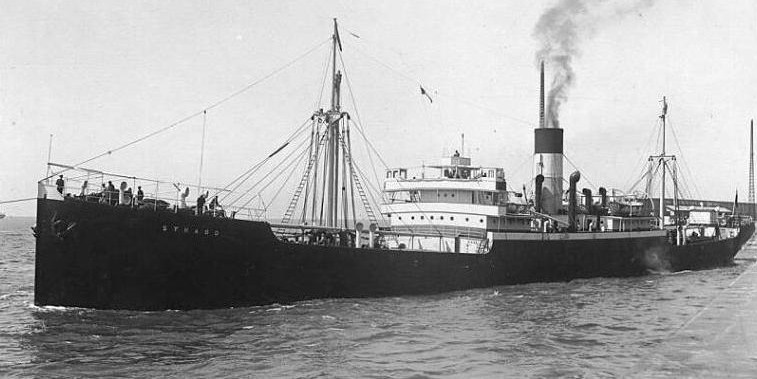RIKUGUN YUSOSEN
 (YAMAYURI MARU. (ex-STRABO), prewar)
(YAMAYURI MARU. (ex-STRABO), prewar)
IJN/IJA YAMAYURI MARU:
Tabular Record of Movement
© 2014-2018 Bob Hackett
1913:
Dumbarton, Scotland. Laid down by Archibald McMillan & Son, as Yard No 451, a 4,910-ton cargo ship for Lamport & Holt Ltd. (W.J. Lamport & G. Holt, Brazil & River Plate Steam Navigation Co. Ltd.) Liverpool.
15 September 1913:
Launched and named STRABO.
October 1913
Completed.
1932:
Sold to Atlanticos Steamship Co., Syria and managed by the Kulukundis Bros. Renamed PAULINE.
1933:
Sold to the African & Continental Steamship Co. Ltd. (Maurice Olivier, London).
1934:
Renamed PAVLINA.
1935:
Sold to Bright Navigation Co. Ltd. (J. G. Bright, London). Renamed BRIGHTVEGA.
1936:
Sold to N. C. Wan of Tsingtao, China. Renamed SHOU SING.
7 July 1937: The Marco Polo Bridge Incident ("First China Incident"):
Hun River, Lukuokiao, China. Imperial Japanese Army (IJA) troops on night maneuvers at the Marco Polo Bridge fire blank cartridges. Chinese troops across the river think they are under attack. They fire live rounds back, but do not cause injuries. At morning roll call, the Japanese discover a soldier missing and assume the Chinese have captured him. The Japanese demand entry to the Beijing suburb of Wanping to look for the soldier, but the Chinese refuse. The Japanese then shell the city. An undeclared war on China begins.
10 January 1938: Operation "B" - The Seizure of Tsingtao:
The Japanese land on unfortified beaches about three miles below Tsingtao’s defenses and take Tsingtao without a struggle. No. 5 and 6 Sasebo IJN Special Naval Landing Force (SNLF) troops land at Shatzekow, 18 miles from Tsingtao and march there on foot. Shortly afterward, KINUGASA, SHINSHO and SHINKO MARUs and four unidentified troopships enter Tsingtao’s harbor and begin disembarking additional SNLF troops. Five destroyers lay off shore. The Japanese post patrols and lower white flags, which had been hoisted on public buildings, in a token of surrender. The Japanese permit foreigners to return to their homes. Before the landings, Chinese military forces destroy all Japanese cotton mills in the region. Japanese forces press on to capture the Tsingtao-Tsinan Railroad, while others continue the drive on Suchow. The IJA then begins a major offensive southwards along the Hankow Railway through Shansi (Shanxi).
1938:
Japanese forces seize SHOU SING. Later, she is operated by Yamashita Kisen K. K., Kobe and renamed YAMAYURI MARU.
5 July 1938:
Requisitioned by the Imperial Japanese Navy (IJN) as an Ippan Choyosen cargo ship (B-AK).
14 December 1938:
The IJN releases YAMAYURI MARU back to Yamashita Kisen K. K.
12 December 1941:
Requisitioned by the Imperial Japanese Army (IJA) as a troop transport. Assigned IJA No. 560.
24 November 1942:
At 0500, YAMAYURI MARU departs Paramushiro, Kuriles for Attu in convoy No. 1 also consisting of KOAN MARU.
29 November 1942:
At 0630, arrives at Attu.
31 January 1943:
Kaibokan HACHIJO departs Paramushiro escorting YAMAYURI MARU bound for Attu.
3 June 1943:
YAMAYURI MARU departs northern Kyushu for Shanghai in convoy SHI-310 also consisting of DAIYA, GYOTEN, KANSAI, NARUO (ex-Panamanian ESTERO), REKIZAN, ROKKO, and TOTAI and UNZEN MARUs and KOTO MARU No. 2 GO escorted by minelayer TAKASHIMA.
5 June 1943:
At 1400, arrives at the Fairway Bell Buoy, near Shanghai.
9 June 1943:
At 1900, arrives at Hong Kong.
12 August 1943:
At 1200, YAMAYURI MARU departs Surabaya, Java escorted by subchaser CH-1.
15 August 1943:
At 1930 arrives at Balikpapan.
20 August 1943:
At 0900, YAMAYURI MARU departs Balikpapan, Borneo in convoy No. 2606 also consisting of AMAGISAN and NICHIAI MARUs and fleet oiler TSURUMI escorted by subchasers CH-4 and CH-5
23 August 1943:
YAMAYURI MARU and CH-5 are detached for Menado and then NICHIAI MARU is detached.
18 September 1943:
At 0500, YAMAYURI MARU departs Palau escorting convoy So-806 consisting of PACIFIC, TAKAOKA, TAMASHIMA and YURI MARUs escorted by subchasers CH-17 and CH-39.
25 September 1943:
At 0900, arrives at Rabaul.
28 September 1943:
At 1200, YAMAYURI MARU departs Rabaul for Palau in convoy O-803 also consisting of CHIYO and SHOUN MARUs escorted by subchasers CH-22 and CH-24.
5 October 1943:
Arrives at Palau and loads rock phosphate.
7 October 1943:
YAMAYURI MARU departs Palau in convoy FU-705 consisting of ADEN, BENGAL, TAIAN and YAMAGATA MARUs escorted by minesweeper W-17.
E 16 October 1943:
At 30N, auxiliary minesweeper AOI, YACHIYO MARUs and TOKUHO MARU No. 10 join the convoy's escort.
17 October 1943:
The convoy arrives at Ujina.
18 December 1943:
At 0100, YAMAYURI MARU departs Saeki in convoy O-806 for Palau also consisting of BICCHU, RYUTO, SHICHISEI, SORACHI and TEMPOSAN MARUs escorted by destroyer HARUKAZE, minelayer YURIJIMA and auxiliary minesweepers TAKUNAN MARU No. 8 and TAMA MARU No. 7.
E 19 December 1943:
At 29N, TAKUNAN MARU No. 8 and TAMA MARU No. 7 are detached.
E 20 December 1943:
At 28N, YURIJIMA is detached.
5 January 1944:
YAMAYURI MARU departs Palau for Rabaul in convoy SO-504 also consisting of CHIBURI, LYONS and NICHIAI, MARUs escorted by subchasers CH-37 and CH-38.
10 January 1944:
New Hanover, Bismarcks. At about 1500, a submarine is sighted on the surface and engaged with gunfire.
11 January 1944:
At 2109, a Consolidated B-24 “Liberator” heavy bomber, probably of the USAAF's 13th Air Force based in the Solomons, attacks the convoy unsucessfully.
12 January 1944:
At 0032, other aircraft attack the convoy and one plane is shot down. Later that day, the convoy arrives at Rabaul.
24 January 1944:
Rabaul. USMC Grumman TBF “Avenger” torpedo-bombers, supported by USN, USMC, USAAF and RNZAF Curtiss P-40E "Kittyhawk" fighters, again attack shipping and sink YAMAYURI, KOAN, LYONS and TAISHO MARUs and damage oiler NARUTO.
Author’s Note:
Little data were found on YAMAYURI MARU's movements in 1942. Readers with access to such data are requested to post the information on the Discussion and Questions board or j-aircraft.org's IJN Ship Message
Board
Bob Hackett
Back
to IJA Transports





